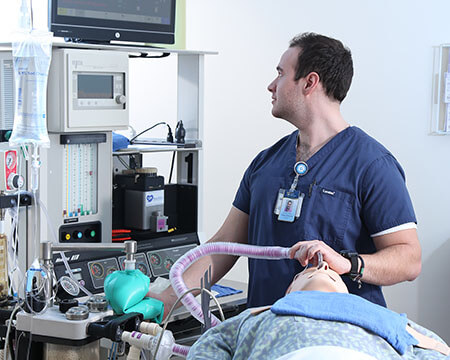Nurse Anesthetists: The Unsung Heroes

Before a surgery, you may have many concerns. Will everything go according to plan? Will I have a large scar? How long will it take me to heal? But after the surgery is completed, your focus is going to be on one thing: pain management.
Making Pain a Priority
Many people acknowledge the importance of pain management. According to the American Academy of Pain Management, “Almost six in 10 adults (57%) say they would be willing to pay $1 more per week in taxes to increase federal funding for the scientific research in to the causes and treatment of pain.”
Long ago, patients were exposed to questionable pain-relief tactics such as arsenic use, electric eel therapy or relying on Coca-Cola to relieve their symptoms. In 1846, the first successful surgical procedure was performed with anesthesia, and advancements in pain management have continued ever since. The first anesthesia procedures came nowhere close to today’s, consisting of chloroform soaked handkerchiefs held over a patient’s nose, or ether on a sponge placed over the patient’s nose and mouth – causing suffocation in some cases.
Nurse Anesthetists
When anesthesia was first introduced, its importance was recognized, but administering it wouldn’t get you the praise, or the paycheck, of a surgeon. In the beginning, the most junior doctor was assigned the job. Unfortunately, the junior doctors would be so interested in the actual surgery, they would neglect the anesthesia. As a result, patients often died during surgery. Surgeons soon reassigned the administration of the anesthetics to the nursing staff. The nurses maintained a careful eye on the patient throughout surgery, and patients fared much better as a result. A new profession was born during this decade – the nurse anesthetist.
Nurse anesthetists could possibly be the best kept secret in medicine today. Nurse anesthetists provide anesthesia and pain management to thousands of patients every day. They administer epidural anesthesia to laboring women, general anesthesia for all types of surgeries, from war injuries to root canals, and post-surgery pain medication.
Anesthesia on the Front Lines
According to the American Association of Nurse Anesthetists, “Nurse anesthetists have been the main providers of anesthesia care to U.S. military personnel on the front lines since WWI. Nurses first provided anesthesia to wounded soldiers during the Civil War.”
Affordable Anesthesia
Nurse anesthetists also offer financial solutions to hospitals, dental offices, pain clinics and more. And, although nurse anesthetists earn competitive salaries, they often cost less for patients and insurance companies than their physician counterparts. Does a lower cost mean lower quality of care? No. According to the AANA, “Numerous outcomes studies have demonstrated that there is no difference in the quality of care provided by CRNAs and their physician counterparts.”
In addition to costing less for patients, becoming a nurse anesthetist also costs less than an anesthesiologist. In fact, about eight nurse anesthetists can be educated for the same cost as one anesthesiologist.
Your Future in Pain Management
Nurse anesthetist frequently report having fulfilling careers and salaries that allow them to live a fulfilling life outside of the operating room.
If you’re considering a career as a nurse anesthetist, you’re making this choice at a wonderful time. Technology has helped to make medicine more precise and effective. Nurse anesthetists utilize technological advances on a daily basis, assuring their patients receive the highest quality of anesthetic care available.
At Texas Wesleyan, we have a competitive and distinguished nurse anesthetist program. For more information on what we have to offer, contact a graduate admissions counselor today.







